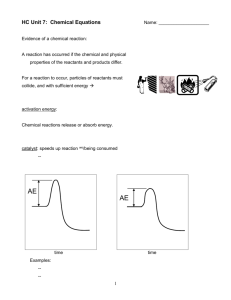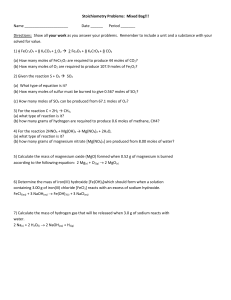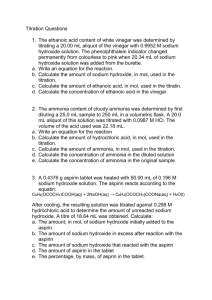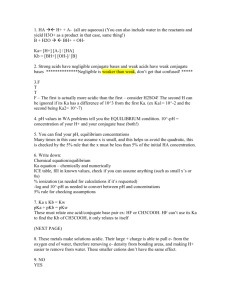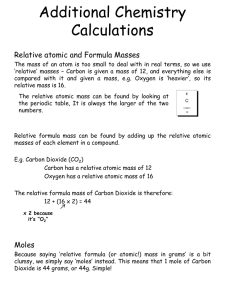CHAPTER 2*SCIENTIFIC METHODS IN BIOLOGY
advertisement
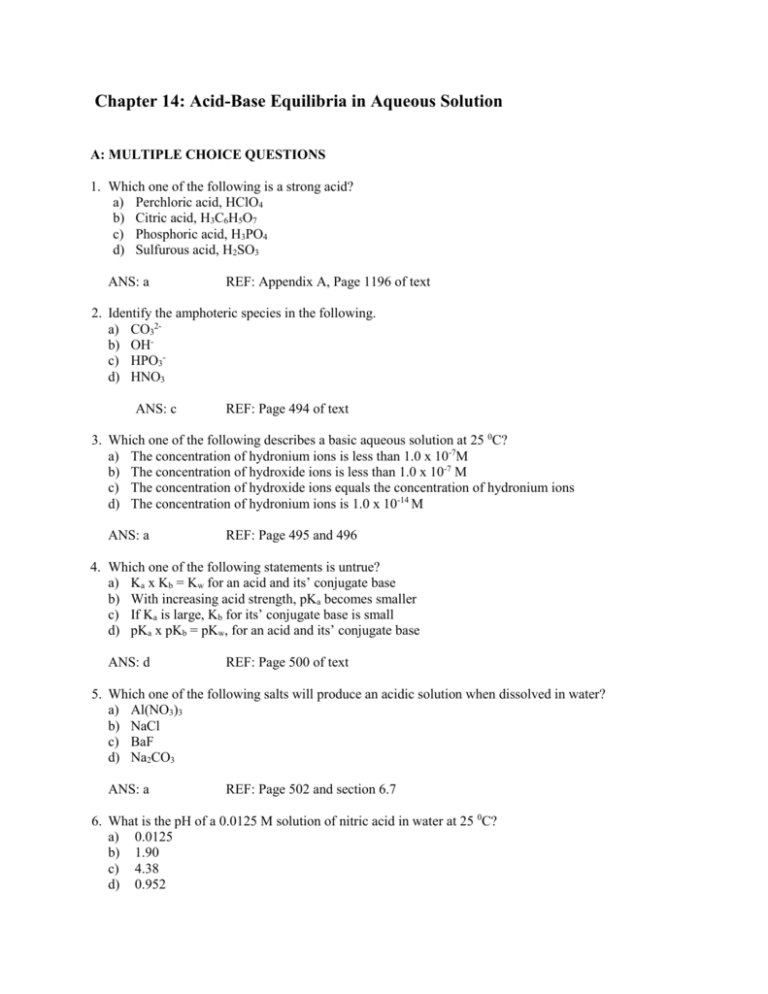
Chapter 14: Acid-Base Equilibria in Aqueous Solution A: MULTIPLE CHOICE QUESTIONS 1. Which one of the following is a strong acid? a) Perchloric acid, HClO4 b) Citric acid, H3C6H5O7 c) Phosphoric acid, H3PO4 d) Sulfurous acid, H2SO3 ANS: a REF: Appendix A, Page 1196 of text 2. Identify the amphoteric species in the following. a) CO32b) OHc) HPO3d) HNO3 ANS: c REF: Page 494 of text 3. Which one of the following describes a basic aqueous solution at 25 0C? a) The concentration of hydronium ions is less than 1.0 x 10-7M b) The concentration of hydroxide ions is less than 1.0 x 10-7 M c) The concentration of hydroxide ions equals the concentration of hydronium ions d) The concentration of hydronium ions is 1.0 x 10-14 M ANS: a REF: Page 495 and 496 4. Which one of the following statements is untrue? a) Ka x Kb = Kw for an acid and its’ conjugate base b) With increasing acid strength, pKa becomes smaller c) If Ka is large, Kb for its’ conjugate base is small d) pKa x pKb = pKw, for an acid and its’ conjugate base ANS: d REF: Page 500 of text 5. Which one of the following salts will produce an acidic solution when dissolved in water? a) Al(NO3)3 b) NaCl c) BaF d) Na2CO3 ANS: a REF: Page 502 and section 6.7 6. What is the pH of a 0.0125 M solution of nitric acid in water at 25 0C? a) 0.0125 b) 1.90 c) 4.38 d) 0.952 ANS: b REF: Page 500 and table 14.5 7. With respect to pK= and pH, which one of the following statements is true? a) pH equals pKa at equilibrium b) pH equals pKa when [HA] = [A-] c) at pH < pKa concentration of HA is greater than [A-] d) in a speciation plot the intersection point equals Ka ANS: b REF: Section 14.7 8. Methionine has a pKa1 of 2.28 and pKa2 of 9.21. Based on this the zwitterion will be present at its’ highest concentration at which one of the following pH values? a) 2.280 b) 9.210 c) 5.745 d) 6.930 ANS: c REF: Page 522 9. An effective buffer cannot be prepared from a mix of sodium nitrate and nitric acid because of which one of the following? a) Nitrate is not the conjugate base of nitric acid b) nitrate ions are not basic c) sodium nitrate is acidic d) the Ka of nitric acid is too small ANS: b REF: Appendix A and Pages 526, 527 10. One of the following cannot be used to prepare a buffer solution. Which one? a) Prepare a solution of sodium hydrogen carbonate (NaHCO3) and add sodium hydroxide (NaOH) until the desired pH is reached b) Prepare a solution of sodium carbonate (Na2CO3) and add hydrochloric acid (HCl) until the desired pH is reached c) Prepare a solution with equimolar amounts of sodium hydrogen carbonate (NaHCO3) and sodium carbonate, (Na2CO3) d) Prepare a solution with equimolar amounts of dihydrogen carbonate (H2CO3) and sodium carbonate, (Na2CO3) ANS: d REF: Section 14.9 B: SHORT ANSWER QUESTIONS 1. Benzoic acid is monoprotic and only poorly soluble in water at 25 0C. At this temperature, a saturated solution is 0.0278M for the acid. It dissociates according to the following equilibrium equation. C6H5COOH(aq) + H2O(aq) ⇋ C6H5COO-(aq) + H3O+(aq) Ka = 6.3 x 10 -5 What is the pH of a saturated solution of the benzoic acid at this temperature? ANS: Acid base equilibrium problems are solved in the same manner as typical equilibria. The primary difference is that equilibrium concentrations of species can then be used to calculate pH of a solution either through [OH-] or [H3O+] at equilibrium. In this case, we have an acid equilibrium and the species at equilibrium that will be used to calculate pH is the H3O+. First we produce an ice table. C6H5COOH(aq) + H2O(l) ⇋ C6H5COO-(aq) + H3O+(aq) I 0.0278 0 0 C -x +x +x E 0.0278 – x x x Ka = 6.3 x 10-5 = x2/(0.0278 – x) Rearranged we have; 0 = x2 + 6.3 x 10-5x – 1.75 x 10-6 Using the quadratic formula; x = 1.29175063 x 10 -3 = 1.29 x 10-3 = [H3O+]eq pH = - log [H3O+]eq = - log (1.29 x 10-3) = 2.89 = 2.9 REF: Pages 508 and 509 2. Lactic acid, H3CCH(OH)COOH, is produced from glycogen by muscle cells in your body during fermentative energy production. This occurs when oxygen is limiting such as during any type of endurance exercise or strenuous exercise. It is monoprotic and has a Ka of 1.4 x 10-4 at 25 0C. What is the % ionization of the acid in a 0.095M solution? ANS: I C E H3CCH(OH)COOH(aq) + H2O(l) ⇋ H3O+(aq) + H3CCH(OH)COO-(aq) 0.095 0 0 -x +x +x 0.095 – x x x Ka = x2/(0.095 –x) = 1.4 x 10 -4 0 = x2 + 1.4 x 10 -4 x – 1.33 x 10-5 equilibrium solving for x we get; x = 3.57 x 10-3 = [H3O+] at % ionization = (amount dissociated/initial concentration) x 100 = (3.57 x 10 -3/0.095) x 100 = 3.76% = 3.8% REF: Pages 508 to 510 3. The common ion effect can be seen when an ionic solution containing a basic salt is treated with an aqueous conjugate acid of that base. The basic anion of the highly soluble salt will acquire a proton and shift the equilibrium away from dissolution of the acid thereby changing the pH of the solution. This can be demonstrated using potassium propanoate and propanoic acid. The equation for dissolution of the sodium propanoate is below. Following is the equation for the reaction of propanoic acid with water CH3CH2COONa(s) ⇋ Na+(aq) + CH3CH2COO-(aq) HCH3 CH2COO(aq) + H2O(l) ⇋ CH3CH2COO-(aq) + H3O+(aq) Ka = 1.38 x 10-5 The presence of the propanoate ions produced through dissolution of the salt, drives the acid equilibrium to the left. Less acid dissociates therefore less hydronium ions are in solution, therefore, a higher pH than would be expected based upon the labeled acid concentration. What is the pH of 100.0 mLs of a 1.0M solution of propanoic acid at 250C to which 15.0 grams of sodium propanoate have been added and dissolved? ANS: Looking at the Ka for propanoic acid, we can see that this is a weak acid. Dissociation is going to be minimal for this acid even in the absence of the salt. The salt, in contrast, is highly soluble and is completely soluble at these concentrations. (most sodium salts of carboxylic acids are highly soluble. Refer back to earlier sections on solubilities of ionic solids). This will result in a high concentration of the weakly basic anion. The common ion effect means that even less of the acid will dissociate than would have in its absence. In fact, the amount of acid that will dissociate is so small that it can be ignored as having little mathematical effect on the final concentration of the base and its conjugate acid in solution at equilibrium. Ignoring this dissociation is sometimes referred to as the “ignore x” method of acid/base calculations. In fact, the resulting solution is actually a buffer. We have the acid and its conjugate base in solution. This means we can use the HH equation and we can use starting concentrations of the acid and the base in our computation since we expect a minimal change relative to the starting levels. No ice table is needed and no quadratic formula. I.e., From the 15.0 grams of propanoic acid we can calculate moles of acid and, from the volume, we can determine the concentration. 15.0 g/ 74.09 g/mole = 0.202456 moles in 0.1000 L = 2.02 M propanoic acid and thus 2.02M propanoate, given 100% dissolution. pH = pKa + log ( [base]/[acid] ) = -log 1.38 x 10 -5 + log(2.02/1.0) = 5.16 REF: Page 511 and section 14.9 4. A buffer is produced by adding 0.10 moles of sodium acetate to a 0.10 M solution of acetic acid. Describe the effect that each of the following will have on the pH of the solution a) Addition of more sodium acetate b) Doubling the volume with deionized water c) Addition of sodium hydroxide ANS: a) More sodium acetate will increase the ratio of conjugate base to acid in the buffer. This shifts the equilibrium to the left where the equilibrium reaction is; CH3COOH(aq) + H2O(l) ⇋ CH3COO-(aq) + H3O+(aq) That decreases the concentration of hydronium ions in solution and thereby increases the pH. b) Doubling the volume has no effect on the pH. pH depends only upon the relative molar ratios of the base and the acid (and the Ka). The ratio does not change, so the pH does not change. c) Sodium hydroxide, as a source of hydroxide ions, will react with the strongest acid in solution. The strongest acid is the hydronium ion. As hydronium ions are consumed, more acetic acid molecules dissociate. The acetate concentration rises and the ratio of the conjugate base to the acid form in the buffer rises. This causes a marginal rise in the pH that depends upon the amount of hydroxide added. REF: Pages 533, 534 5. What will be the pH of a buffer solution made from 0.300 M acetic acid and 0.300 M sodium acetate to which 5.0 grams of sodium hydroxide have been added to 1.0L of the buffer? ANS: For these problems, assume that the final concentration of the acid and its conjugate base, at equilibrium and prior to adding the base, is the same as the starting concentrations. This is a safe assumption because both the acid and its conjugate base are weak and dissociation is minimal, even in the absence of the counter ion. In their presence, it’s very minimal. Then, simply do the stoichiometry of addition, assuming that the strong base reacts completely with the acidic species in solution. Our initial conditions are; CH3COOH + H2O ⇋ CH3COO- + H3O+ I 0.300 M 0.300 M In 1.0L there are 0.1 moles 0.1 moles After addition of the NaOH, some of the acetic acid is converted to acetate ion and water. There are 5.0 grams of the NaOH. At 40.00 g/mole this is 1/8th of a mole = 0.125 moles. As a monoprotic acid, acetic acid reacts 1 to 1 with NaOH thus 0.125 moles of the acetic acid are converted to acetate ion. The moles of acetate ion in solution increases by 0.125 moles and the moles of acetic acid decreases by 0.125 moles The new concentrations are; 0.175 M CH3COOH and 0.425M CH3COOpH = pKa + log ([base]/acid]) = - log 1.8 x 10 -5 + log (0.425/0.175) = 5.13 REF: Page 534 6. Propanoic acid has a Ka of 1.38 x 10-5 at 25 0C. At what pH will the concentration of the acid be the same as the concentration of the conjugate base in water, at 25 0C? ANS: The concentrations of the two species will be the same when the pH of the solution equals the pKa of the acid. pKa is the –log Ka. Therefore pKa = - log 1.38 x 10-5 = 4.86 and the pH = 4.86 . REF: Section 14.7 7. The amino acid isoleucine has a non-acidic and non-basic side chain but Ka1 for the carboxylate group is 2.36 and Ka2 from the amino group is 9.60. Which species will be present at pH 9.0 and to what relative degree, Ile-, H-Ile0, or H2 Ile+ and why? ANS: The isoelectric point for isoleucine is the pH halfway between pKa1 and pKa2. This is expected to occur at (2.36 + 9.60)/2 = 5.98. However, referring to table 14.10 we see that the isoelectric point is actually 6.02. At the isoelectric point the solution contains almost exclusively the neutral zwitterionic species where the carboxylate is ionized as -COO- and the amine is protonated as – NH3+ . pH 9.0 is nearer the second pKa than it is the isoelectric point. At the second pKa, the concentration of the zwitterions, [H-Ile], = [Ile-]. pH 9.0 being to the acidic side of the second pKa , there should be somewhat more of the monoprotonated zwitterionic amino acid, HIle, in solution than the completely deprotonated form, Ile-. REF: Page 522 8. What is the pH of a solution containing 0.33 moles of trichloroacetic acid and 0.45 moles of sodium trichloroacetate (the sodium salt of its conjugate base) in 1.00 L if the Ka of the acid is 0.316? ANS: The pH is a function of the ratio of the conjugate base to the acid. Typically, the Henderson Hasselbach equation is used where pH = pKa + log [base]/[acid] But the ratio of the moles will also work without converting to concentrations because the ratio remains a constant regardless of volume. pH = pKa + log (moles base/moles acid) = - log Ka + log (nbase/nacid) = - log (0.316) + log (0.45/0.33) = 0.635 REF: Page 527 and 529 9. Hydrogen cyanide has a pKa of 9.21. Prepare a buffer solution with a pH of 9.6 using hydrogen cyanide. ANS: You can either dissolve hydrogen cyanide gas in water and add sodium hydroxide to arrive at the required pH (this can be calculated using stoichiometry and the HH equation) or you can use sodium cyanide and add HCl to arrive at the desired pH (can also be pre-calculated) or you can add pre-calculated amounts of hydrogen cyanide and sodium cyanide to the water to arrive at the desired pH. In the latter case, ideally, you add enough of each to make the buffer useful, that is, to have adequate buffering capacity. To arrive at relative ratios, use the Henderson Hasselbach equation (HH equation). pH = pKa + log (base amount or concentration/acid amount or concentration) 9.6 = 9.21 + log (A-/HA) then; 0.39 = log (A-/HA) and; 100.39 = A-/HA = 2.45 Thus; the ratio of base to acid is 2.45 to 1. Perhaps 2.45 moles of sodium cyanide and 1 mole of hydrogen cyanide diluted to 1.0L volume using distilled and deionized water at 25 0C. Gas can be bubbled through the solution in a controlled cycle. This may exceed the gas solubility (which wouldn’t be wise given its toxicity) and solubility would need to be checked prior to prep. (It would simply be unwise to prepare this buffer at all!) REF: Pages 530, 531 10. A stock solution of sodium hydroxide is labeled as 0.300M but needs to be titrated prior to use as a titration standard since it has been stored for several months. 25.00 mL of the solution are titrated in three separate titrations. The acid used is solid potassium hydrogen phthalate. It is a primary standard for titration of bases. Its’ structure is below. This salt of the acid is monoprotic. It does tend to absorb moisture from the air but can be kept anhydrous if stored in a dessicator. I is stable at room temperature (doesn’t decompose), is highly soluble in water, and the acid product is also water soluble; remaining in solution upon formation. It is usually purchased as a dry solid and stock solutions can be freshly prepared as needed. It will react stoichiometrically with a strong base. A 0.500 M stock solution of the acid is used in the titration. The following data was collected. Volume of base Volume of titrant titrated (mL) 25.00 25.00 25.00 Trial 1 Trial 2 Trial 3 added (mL) 14.67 14.74 14.63 What is the concentration of the base? ANS: When doing titrations, empirically obtained measures are averaged to arrive at a more accurate value. If one value deviates significantly from others, it is discarded as an outlier. The values given are relatively close and on a subjective basis, I choose to include all three. The average volume is 14.68 mL. Converted to litres, this is 0.01468L Moles of acid used = 0.01468L x 0.500 moles/L = 0.007340 This is a monoprotic acid and sodium hydroxide is monobasic. They react in a 1 to 1 stoichiometric ratio. Therefore; there are 0.00734 moles of NaOH in each 25.00 mL volume of the stock. The concentration of the sodium hydroxide is; 0.007340 moles/0.02500L = 0.2936M REF: Section 14.10 C: LONG-ANSWER QUESTIONS 1. In example 14.9 of your text, a calculation is done using carbonate ion and hydrogen carbonate reactions with water to predict the pH of 0.100 M solution of carbonate. You are told that if the difference between Ka1 and Ka2 of a diprotic acid or Kb1 and Kb2 of a dibasic base is great, then the second dissociation can be ignored. This is true for relatively concentrated solutions of acids and bases, respectively. However, for dilute solutions, the second dissociation step sometimes does make a significant contribution. In such a case, the concentration of the species in solution is calculated using a sequential series of calculations. The concentrations of the products, at equilibrium, from the 1st dissociation are used as starting concentrations for the second dissociation. At each step, the Ka or Kb (depending upon whether it’s an acid or a base) for that particular dissociation reaction is used in calculations Calculate the pH of a 0.000010 M solution of tribasic sodium phosphate using; a) Just the 1st base dissociation equilibrium, Kb1 = 2.08 x 10 -2 b) The 1st and 2nd dissociations in series (values from step a as starting concentrations for K b2), Kb2 = 1.61 x 10-7 NS: a) I C E PO43-(aq) + H2O(l) ⇋ HPO42-(aq) + OH-(aq) 0.000010 -x 0.000010 –x 0 +x x Kb1 = 2.08 x 10 -2 = x2/ (0.000010 –x) pH = 14 – (-log 9.61 x 10-6) = 8.98 b) 0 +x x solve for x and we get; x = 9.61 x 10-6 = [OH-] HPO42-(aq) + H2O(l) ⇋ H2PO4-(aq) + OH-(aq) I C E 9.61 x 10 -6 -x 9.61 x 10 -6 –x 0 +x x 9.61 x 10-6 +x 9.61 x 10-6 + x Kb2 = 1.61 x 10 -7 = x (9.61 x 10 -6 +x) / (9.61 x 10 -6 –x) 0 = x2 + 9.77 x 10 -6 -1.547 x 10-12 solved for x we have; rearranged we have; x = 1.56 x 10 -7 pH = 14 – (- log 1.56 x 10-7) = 7.19 Notice the large difference in pH between the two calculations. Failure to consider the second dissociation results in a much higher pH (approximately 10 times more basic) than is really the case. REF: Narrative C-1 2. Nitrous acid, HNO2, has a Ka of 4.5 x 10-4 at 250C . A solution of nitrous acid of 0.500 M concentration is titrated with sodium hydroxide standard of 0.500 M concentration. Assuming you have started with 50 mL of the the nitrous acid, calculate the pH of the solution after; a) Addition of 20.00 mL of the base to 50.00 mL of the acid b) Addition of one half molar equivalent of the base to 50.00 mL of the acid c) Addition of one molar equivalent of the base to 50.00 mL of the acid ANS: a) 20.00 mL of the sodium hydroxide can be converted to moles as follows; 0.02000 L x 0.500 M = 0.01000 moles of OHNitrous acid is a weak acid as evidenced by its small Ka of 4.5 x 10-4. If the concentration is significantly higher than the Ka (usually a thousandfold or greater) then dissociation can be ignored as a factor in the final pH. Instead, we assume that we are starting from a situation where None of the nitrous acid has dissociated. Then addition of sodium hydroxide converts a predictable stoichiometric quantity of the acid to its’ conjugate base. The second product is water. This results in a buffered solution since we have a weak acid and its’ conjugate base in solution. Initially we have 50.00 mL of the acid at 0.500 moles/L. This is 0.025 moles of the acid. Addition of 0.01000 moles of hydroxide converts 0.01000 moles of the acid to its’ conjugate base. We now have a buffer and pH = pKa + log[base]/[acid] = - log(4.5 x 10-4 ) + log(0.01000/0.015) = 3.17 Ask yourself; is this a logical answer? Yes, it is. We started with a weakly acidic solution and added base but not to the equivalence point. The acid is not yet fully neutralized and thus the solution is still acidic. b) After addition of ½ molar equivalent of the sodium hydroxide, half of the acid will be converted to its’ conjugate base. At this point the ratio of [base]/[acid] concentration in the buffer is 1 to 1. In the HH equation, the log of 1 is zero. Therefore; pH = pKa + 0 = pKa The pH at this point = pKa of nitrous acid = - log 4.5 x10-4 = 3.34 c) At 1 molar equivalent, all of the nitrous acid has been converted to nitrite ion and water through reaction with the hydroxide ions. The only species in solution still able to react with water is the nitrite ion. Its’ concentration will be dependent upon the moles of acid we started with and the final volume. Since our sodium hydroxide solution was the same concentration as the nitrous acid, the final volume is doubled. The moles of nitrous acid present initially were calculated in step a of this question to be; 0.02500 moles in 50.00 mL. We now have 0.02500 moles in 100.00 mL. This is 0.250 M (1/2 the initial concentration of 0.500M) The nitrite ion can react with water to form nitrous acid according to the following equilibrium reaction; NO2-(aq) + H2O(l) ⇋ HNO2(aq) + OH-(aq) I 0.500 C -x E 0.500 –x +x 0 +x x 0 x Kb = Kw/Ka = 1.0 x 10-14/4.5 x 10-4 = 2.22 x 10 -11 Kb = x2/ (0.500 –x) solving for x we have; x = 3.33 x 10-6 = [OH-] pH = 14 – pOH = 14 – (-log 3.33 x 10-6) = 8.52 = 8.5 The solution is basic because the acid titrated was weak and the conjugate base of a weak acid is a weak base. REF: Pages 540, 541 3. Contrast the pH at equivalence for titrations of; a) Strong acid with strong base b) Weak base with strong acid c) Weak acid with strong base d) Weak base with weak acid ANS: a) When a strong acid is titrated with a strong base the products of the reaction are neutral. For example; HCl and NaOH when mixed produce NaCl(aq) and HOH(l). The NaCl is completely soluble and the sodium ions are not acidic or basic. Similarly, the chloride ions are neither acidic nor basic. HOH is actually, H2O, when written conventionally, and water is neutral. The solution is neutral provided the acid and base have reacted to stoichiometric equivalence (fully neutralized). b) A weak base reacting with a strong acid will result in formation of the conjugate acid of the weak base. As an acid, it will react with water to form an acidic solution. c) A weak acid reacting with a strong base will form the conjugate base of the weak acid. This weak base will react with water to form hydroxide ions and the conjugate acid of the base. The solution will be basic. d) A weak base and a weak acid will react to a limited degree. As long as the base is a stronger base than water then it will preferentially accept protons from the weak acid. Ultimately, the final pH will be determined by the relative strengths of the species present at equivalence. For example: if we mix acetate ion with ammonium ion, at equivalence, we will have ammonia and acetic acid plus whatever ammonium and acetate that haven’t reacted. If acetic acid is a stronger acid than ammonia is a base (when reacting with water), then the solution will be acidic to a limited degree. If the reverse is true, the solution will be basic; also to a limited degree. Regardless, it will either be only weakly basic, or only weakly acidic, depending upon the final concentrations of all species. These are somewhat complex calculations and exceed the mandate of this course. REF: Section 14.10 4. What is the pH of a 0.50 M solution of acetic acid that has been titrated to the end-point (equivalence point) with 0.50 M NaOH? The Ka for acetic acid is 1.8 x 10-5. ANS: Because acetic acid is a weak acid, its’ conjugate base is significantly basic. At the end-point of this titration the hydroxide ions of the sodium hydroxide have all been neutralized by reaction with protons from the acetic acid. The only species in water that is still reactive with water molecules is the conjugate base of acetic acid, the acetate ion. The pH of the water will be determined by the concentration of this base in solution and its’ Kb. The starting concentration of the acid was 0.50M. The starting concentration of the sodium hydroxide is also 0.50M. |Then, since they react 1 to 1, it will require an equal volume of base to reach the equivalence point of the titration. This means the volume will double by time the titration ends. At double the volume the concentration of the acetate ion will be half the original concentration of the acid, acetic acid, from which it was produced. This means that the concentration of the acetate ion at equivalence will be 0.25M. Now, from Ka of acetic acid, we can calculate Kb of its’ conjugate base using Kw=Ka x Kb Kb = Kw/Ka = 1.0 x 10 -14/1.8 x 10 -5 = 5.55 x 10-10 Then, using an ice table; CH3COO-(aq) + H2O(l) ⇋ CH3COOH(aq) + OH-(aq) I 0.25 0 0 C -x x x E 0.25 –x x x Kb = 5.55 x 10-10 = x2/(0.25 – x) Solving for x = 1.178 x 10-5 -5 pOH = -log[OH-] = - log 1.178 x 10 = 4.929 pH = 14 – pOH = 14 – 4.929 = 9.07 = 9.1 REF: Pages 538, 539 5. 75.0 mL of 1.00 M of the diprotic acid sulfurous acid is to be titrated with 1.00 M NaOH. Sulfurous acid, H2SO3 has a Ka1 of 1.41 x 10-2 and Ka2 of 1.0 x 10 -7. a) What volume of sodium hydroxide is required to reach the 2nd equivalence point? b) What is the pH at the first equivalence point? c) What is the pH at the 2nd equivalence point? ANS: a) The balanced chemical reaction for the titration is; H2SO3(aq) + 2NaOH(aq) ⇋ SO32-(aq) + 2H2O(l) We require two moles of NaOH for every one mole of H2SO3 in solution. Conveniently, given that the concentration of the acid is the same as the concentration of the base, we will require two volumes of the base to neutralize all of the acid (twice as many moles). Thus, the titration will require 150 mL of NaOH. (ordinarily we would calculate moles of acid present; use the balanced equation to predict stoichiometric quantities of each reacting then calculate volume required, however, unitary concentrations were chosen for ease of calculations). b) The first equivalence point depends upon the following balanced equilibrium; H2SO3(aq) + NaOH(aq) ⇋ HSO3-(aq) + H2O(l) At the equivalence point, all of the NaOH will have reacted. H2SO3 as the strongest acid in solution will give up one proton per molecule to form HSO3- and water. The concentration of the HSO3- in solution is; [0.075L x (1.00moles/L)] / (0.075L + 0.075L of added NaOH) = 0.5M The second proton will be subject to reaction with the strongest base in solution at equivalence. Since at equivalence, all of the hydroxide is consumed the strongest base remaining in solution is water. The reaction with water is as follows; I C E HSO3-(aq) + H2O(l) 0.5M -x 0.5 – x ⇋ SO32-(aq) + H3O+(aq) 0 0 +x +x x x Ka2 = 1.0 x 10-7 = x2/(0.5 – x) and x = 2.236 x 10-4 pH = - log (2.236 x 10-4) = 3.65 c) At the 2nd equivalence point, another molar equivalent of sodium hydroxide has reacted. HSO3- is the strongest acid in solution and it is all converted to SO32- through reaction with the hydroxide ions. No OH- from the sodium hydroxide remain assuming equivalence with the starting acid. The only species reacting with water at equivalence is the sulfite ion, SO32according to the following equilibrium. The number of moles of sulfite ion is the same as the moles of sulfurous acid we started with but the concentration has been diluted by addition of two volumes of sodium hydroxide. [SO32-] = 0.075 moles/ (0.075L + 0.075L + 0.075L) = 0.333M (ie; 1/3 the original acid concentration of 1.00M) I C E SO32-(aq) + H2O(l) ⇋ HSO3-(aq) + OH-(aq) 0.333 0 0 -x +x +x 0.333 – x x x Solving for x we get; x = 1.82 x 10 -4 = [OH-] pH = 14 – (- log 1.82 x 10 -4) = 10.26 = 10.3 REF: Pages 540, 541 Kb = 1.0 x 10-14/Ka2 = 1.0 x 10 -7


